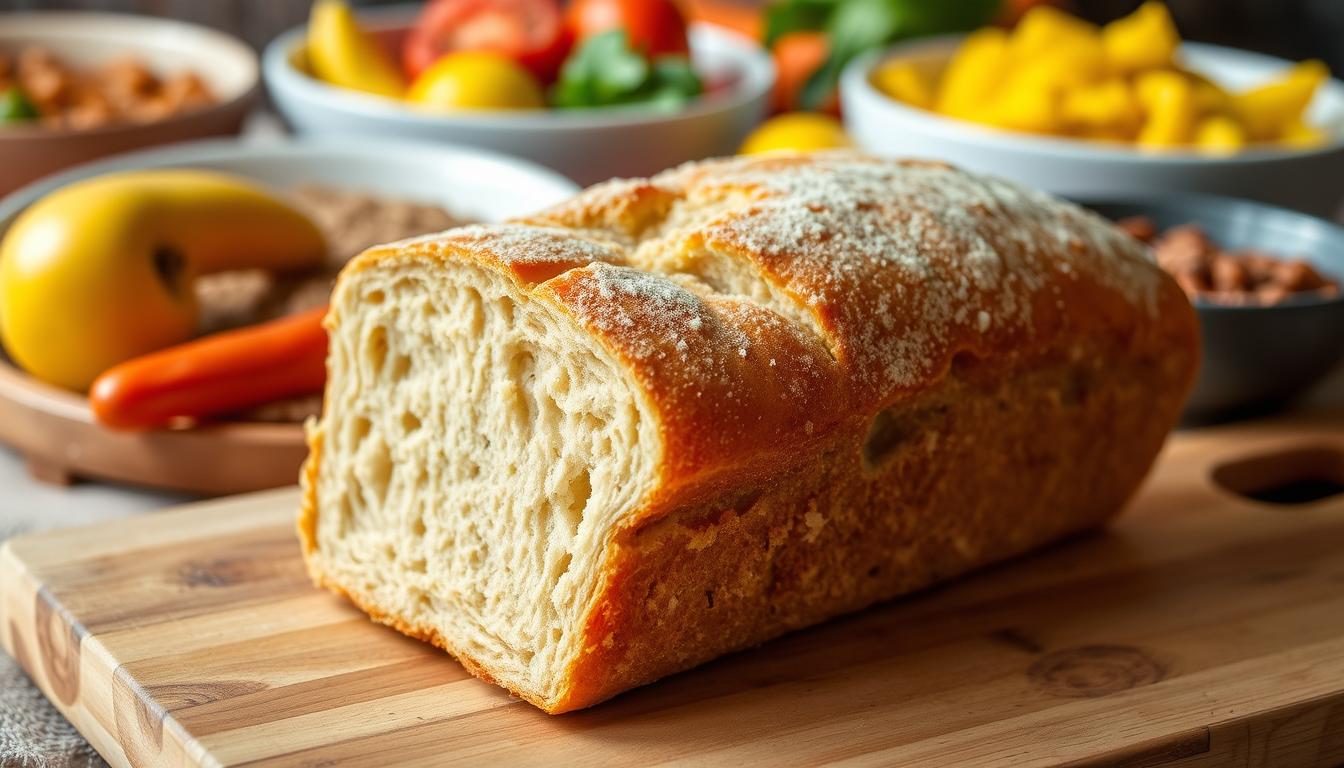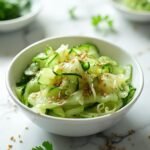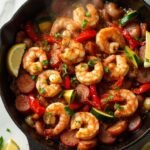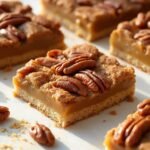Cuban bread is a key part of Cuban-American food. It’s the go-to for making a real Cuban sandwich. This bread is like French or Italian bread but has a special touch.
- Origins and History of Cuban Bread
- Characteristics of Traditional Cuban Bread
- What Makes Cuban Bread Different?
- Ingredients and Recipe for Cuban Bread
- Cuban Bread’s Role in Cuban Sandwiches
- Baking and Serving Cuban Bread
- Cultural Significance of Cuban Bread
- Where to Find Authentic Cuban Bread
- Storing and Enjoying Cuban Bread
- Conclusion
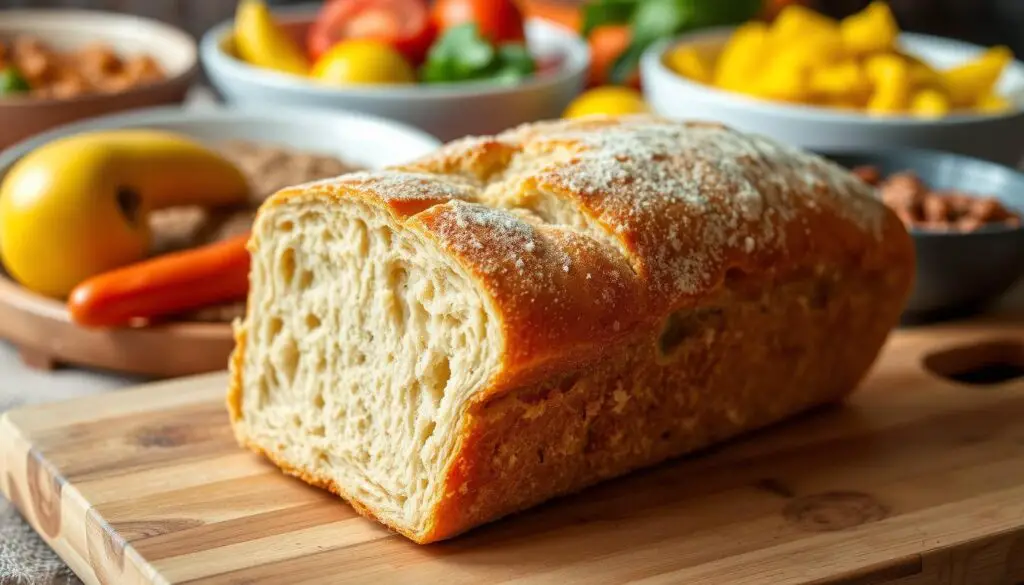
It has a bit of fat, like lard or shortening, in it. Cuban bread is famous for its crispy outside and soft inside. This makes it stand out from other breads.
The special qualities of traditional Cuban bread are vital for the Cuban sandwich, or “Cubano.” This sandwich has roasted pork, ham, Swiss cheese, pickles, and mustard. All these ingredients come together between slices of this unique bread.
The mix of textures and tastes is what makes the Cuban sandwich so loved in Cuban-American cuisine.
Origins and History of Cuban Bread
There’s a debate about where “real” Cuban bread comes from. Miami and Tampa, Florida, both say they have the best. But, the first bakery to make it in the U.S. was La Joven Francesca in Ybor City, Tampa, Florida. It was started by Francisco Ferlita, a Sicilian, in 1896.
La Joven Francesca Bakery and Francisco Ferlita
Francisco Ferlita opened La Joven Francesca bakery in 1896. It quickly became famous for its Cuban bread. The bakery made about 35,000 loaves a week until 1973.
Now, the bakery is the Ybor State Museum. It was renovated in 1977. It keeps the history of this Tampa landmark alive.
Juan Moré and La Segunda Bakery
Juan Moré played a big role in Tampa’s Cuban bread history. He came from Spain via Cuba. Moré joined a bakery co-op and later bought La Segunda.
Today, La Segunda is the biggest Cuban bread maker. They ship their bread all over Florida and more.
“Cuban bread changed its shape during the Cuban war for independence due to a shortage of flour.”
The traditional Cuban bread is about three feet long. It’s rectangular and has a hard, thin crust. The inside is soft and flaky. This makes Cuban bread a key part of Tampa’s and the Cuban-American community’s food heritage.
Characteristics of Traditional Cuban Bread
Traditional Cuban bread is special because of its unique features. It’s a long, rectangular loaf, unlike other breads. This shape comes from an old tradition of stretching the dough thin.
This makes the bread have air pockets and a distinctive shape. The crust is hard and thin, almost like paper. It looks slightly toasted.
The inside of the loaf is soft and flaky. This contrast between the crispy outside and the soft inside is what makes Cuban bread so loved.
A special technique is used in baking. A long, moist palmetto frond is placed on top of the loaves. This creates a shallow trench on the crust.
This trench adds to the bread’s beauty and texture. It’s a key part of what makes Cuban bread so unique.
Texture and Appearance
- Elongated, rectangular shape, unlike rounder European-style loaves
- Hard, thin, and almost papery crust with a subtly toasted appearance
- Soft, flaky, and airy interior, creating a delightful contrast in texture
- Shallow trench on the upper crust, created by a moist palmetto frond
The unique features of Cuban bread make it a favorite in Cuban cuisine. Its shape, crust, and soft interior are key. These qualities make it a must-have for the famous Cuban sandwich.
“The contrasting texture of Cuban bread, crispy on the outside and airy on the inside, enhances its unique flavor profile.”
What Makes Cuban Bread Different?
The Cuban bread is known for its unique texture and flavor. It’s thin and crunchy on the outside, but soft and airy inside. This makes it perfect for being pressed, with a delightful contrast of soft and crispy.
Cuban bread combines the best of baguettes and brioche. It has the shape of a baguette and the soft interior of brioche. But it has its own special flavor and texture. This makes Cuban bread a favorite in Cuban-American cuisine.
| Characteristic | Cuban Bread | Baguette | Brioche |
|---|---|---|---|
| Shape | Long, slender loaf | Long, thin loaf | Rounded, enriched loaf |
| Crust | Thin, crispy | Thick, crunchy | Soft, light |
| Crumb | Soft, airy | Dense, chewy | Rich, buttery |
| Flavor | Slightly sweet, savory | Wheat-y, nutty | Eggy, sweet |
The table above shows the main differences between Cuban bread, baguettes, and brioche. Cuban bread has its own unique shape, crust, crumb, and flavor. These qualities make it a special bread, deeply connected to Cuban traditions.
Ingredients and Recipe for Cuban Bread
Bread Flour, Lard, and Overnight Starter
The traditional Cuban bread recipe is a mix of simple yet tasty ingredients. It starts with bread flour, which gives the bread its chewy texture. The addition of lard or shortening makes it soft and fluffy. The starter adds to the bread’s rich flavor.
To make the perfect Cuban bread, the dough is made in two steps. First, an overnight starter is created. Then, the remaining ingredients are added the next day. This slow process makes the bread smell amazing and have a chewy crumb.
| Ingredient | Quantity |
|---|---|
| Bread Flour | 2 cups |
| All-Purpose Flour | 2 cups |
| Warm Water (divided) | 1¼ cups |
| Active Dry Yeast | 1 tbsp |
| Sugar | 2 tbsp |
| Salt | 1 tsp |
| Lard (or Vegetable Shortening) | ¼ cup |
The overnight starter is key to the bread’s structure and rise. It’s like making sourdough. This process lets the dough ferment and develop flavors overnight, making the bread truly authentic.
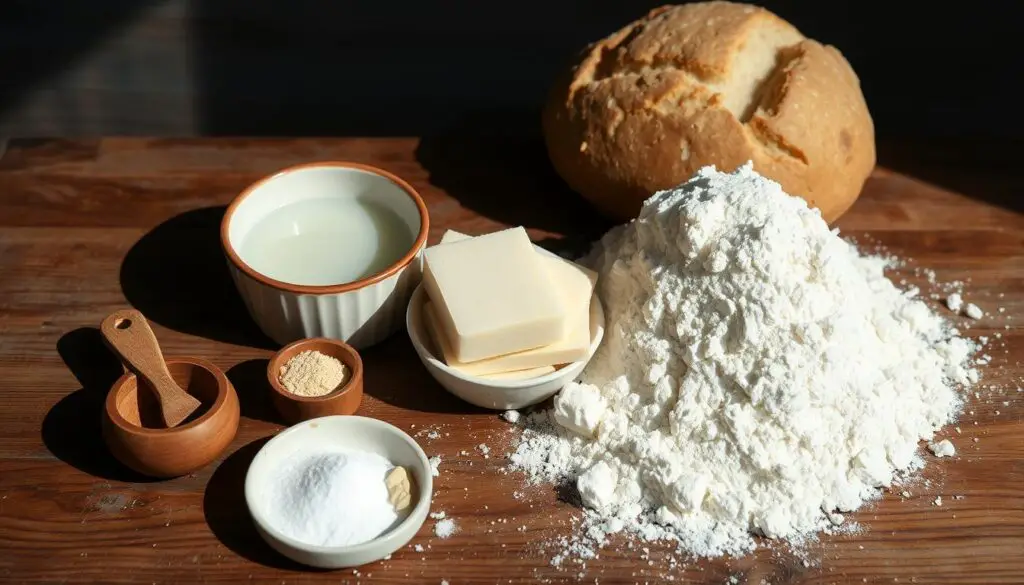
Cuban Bread’s Role in Cuban Sandwiches
The Cuban sandwich, also known as the “Cubano,” is all about the bread. It’s crunchy outside and soft inside. This makes it the perfect base for the sandwich, filled with ham, roasted pork, Swiss cheese, pickles, and mustard.
In the United States, many restaurants have tried their own versions of the Cuban sandwich. But the real deal is always pressed on a hot plancha. This makes the Cuban bread crunchy. Changing the bread can really change how the sandwich tastes and feels.
The Essential Ingredients
The key ingredients in a traditional Cuban sandwich include:
- Cuban bread: The foundation of the sandwich, providing the perfect balance of crunch and softness.
- Roasted pork: Typically marinated in a mojo sauce with citrus, garlic, and spices, the roasted pork is the star of the show.
- Ham: A classic addition that adds saltiness and depth of flavor.
- Swiss cheese: Melted to perfection, the Swiss cheese binds the fillings together.
- Pickles: Dill pickles provide a tangy, crunchy contrast to the other ingredients.
- Mustard: A simple spread of yellow mustard ties all the flavors together.
When these ingredients are combined and pressed on a hot griddle, the result is a Cuban sandwich that is truly greater than the sum of its parts. The Cuban bread is key to this experience.
The debate over the best version of the Cuban sandwich goes on. Different parts of Florida claim to have the authentic version. But no matter the style, the Cuban bread is always essential. It ties the sandwich together and makes it a classic favorite.
Baking and Serving Cuban Bread
Making the perfect Cuban bread needs careful steps for proofing, baking, and serving. The dough grows almost double in size, taking about an hour. This slow growth is key for the crust and soft, airy interior that Cuban bread is known for.
To bake, the dough is moved to a floured surface and shaped into long, baguette-like loaves. The loaves get a dusting of flour and a score down the middle. This helps them expand evenly in the hot oven, set at 400°F (205°C). They bake for 45-50 minutes until the crust turns golden brown.
Proofing, Baking, and Serving Tips
- Proof the dough until it nearly doubles in size, around 1 hour.
- Form the dough into long, baguette-like loaves and score the tops.
- Bake the loaves at 400°F (205°C) for 45-50 minutes for a perfect crust.
- Allow the freshly baked Cuban bread to cool for about an hour on a wire rack before slicing.
- Serve the warm, crusty Cuban bread as a simple breakfast, toasted with butter, or as the base for a classic Cuban sandwich.
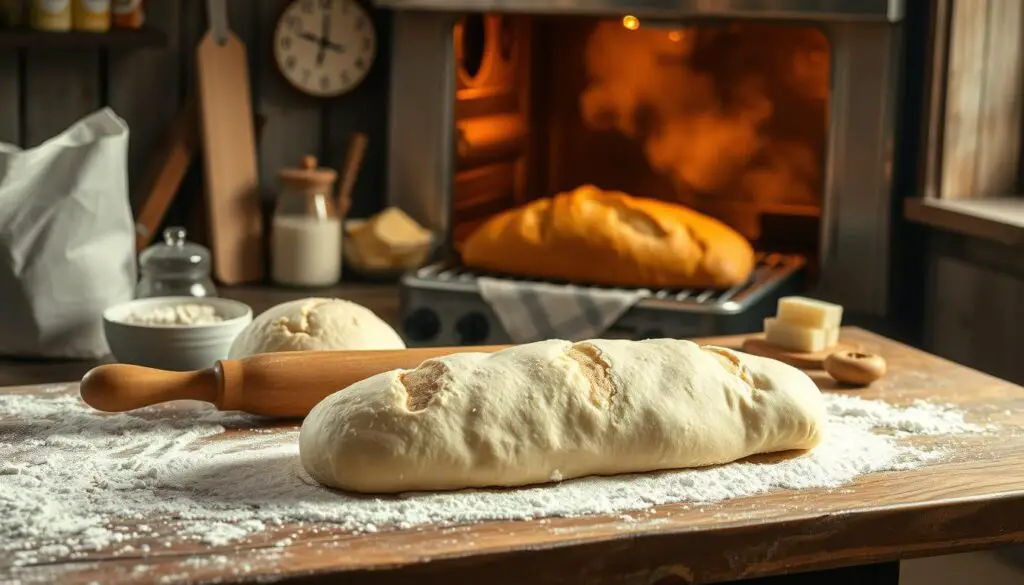
Cuban bread is a joy to bake and eat. Its unique shape, delicious crust, and soft crumb make it special. By learning the proofing and baking methods, you can enjoy Cuban flavors in your own kitchen.
Cultural Significance of Cuban Bread
Cuban bread is very important to Cuban-Americans, mainly in Florida. It’s a comfort food that reminds them of home. It’s also key to Cuban traditions and food.
Getting care packages with Cuban bread brings joy. It also brings back happy memories of eating a whole loaf as kids. The Cuban sandwich, loved in Florida, needs authentic Cuban bread to be complete.
The history of Cuban bread in Florida started in the late 1800s and early 1900s. Ybor City in Tampa welcomed many Cuban immigrants. Bakeries like La Segunda helped keep the traditional Cuban sandwich alive.
Now, Cuban bread is more than just for Cuban-Americans. It shows Florida’s rich food culture. Different parts of Florida have their own Cuban sandwich styles.
“The Cuban sandwich has become a culinary staple throughout Florida, with regional variations like the ‘Tampa-style’ Cuban and the Miami-inspired Cuban being embraced by different communities.”
The love for Cuban bread’s original recipe shows the community’s pride. Cuban-Americans keep sharing their food traditions. Cuban bread is a big part of Florida’s food scene.
Where to Find Authentic Cuban Bread
Cuban bread is easy to find in Florida but hard to find outside the state. The “Cuban Bread Line” is a term for the area where you can easily find it. This line is just north of Tampa. Outside this area, finding Cuban bread gets tough, with many places using substitutes.
For those outside Florida, ordering Cuban bread online is a good option. La Segunda Central Bakery in Tampa is a top choice. They’ve been making Cuban bread for over 100 years. They sell fresh and frozen Cuban bread to many places across the country.
La Segunda bakes over 15,000 loaves every day. They work with big names like Columbia Restaurant and Beef ‘O’ Brady’s. If you want Cuban bread for your restaurant, contact Giuseppe at 813-810-6920.
The Cuban bread recipe from La Segunda uses specific weights. It includes water, salt, sugar, yeast, flour, and shortening. This recipe has been passed down for generations, keeping the bread’s authentic taste and texture.
“La Segunda has been the premier Cuban bread bakery in the Tampa Bay area for over 100 years.”
Storing and Enjoying Cuban Bread
Cuban bread is a true delight, but it doesn’t last long because it lacks preservatives. Without the right storage, it can quickly become stale and dry. But, with a few simple steps, you can enjoy its unique taste and texture for longer.
To keep your Cuban bread fresh, wrap it tightly in plastic wrap or a resealable bag. This keeps the bread moist and prevents it from drying out. A fresh loaf can last up to 48 hours before it starts to go stale.
If you need to store your Cuban bread for longer, freezing is a good option. Wrap the loaf tightly in plastic wrap or foil. It can stay in the freezer for several weeks. Just thaw it at room temperature before enjoying it again.
There are many ways to enjoy Cuban bread. You can have it on its own, toasted with butter, or as the main ingredient in a Cuban sandwich. Its unique texture and subtle sweetness complement the bold flavors of the sandwich, making it a true taste of Cuban culture.
So, whether you’re storing your Cuban bread for later or enjoying it right away, handle it with care. This way, you can fully appreciate its delightful and authentic taste.
| Characteristic | Description |
|---|---|
| Shelf Life | 24 to 48 hours before going stale |
| Storage | Tightly wrapped in plastic or frozen for longer storage |
| Serving | Enjoyed on its own, toasted, or as part of a Cuban sandwich |
Conclusion
Cuban bread is a beloved part of Cuban-American culture, mainly in Florida. It has a crispy crust and a soft, flaky inside. This makes it perfect for Cuban sandwiches.
There’s a debate about where Cuban bread comes from. But its role in Cuban-American cuisine is clear. It’s a cultural symbol.
Cuban bread is hard to find outside its usual places. It’s a symbol of home and community for many. Its unique taste and texture are familiar to those who grew up with it.
The story of Cuban bread’s origins is lively. New versions of Cuban sandwiches keep appearing. Cuban bread is a key part of culinary tradition.
It shows the rich cultural exchange that has shaped Florida’s cuisine. As people look for authentic foods, Cuban bread’s legacy will keep inspiring. It will help keep Cuban-American flavors alive.


